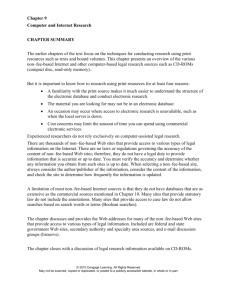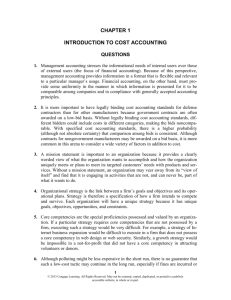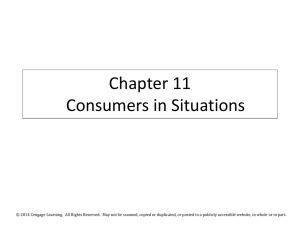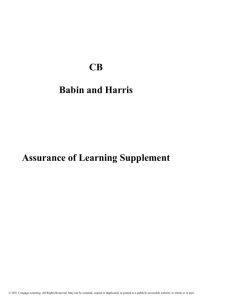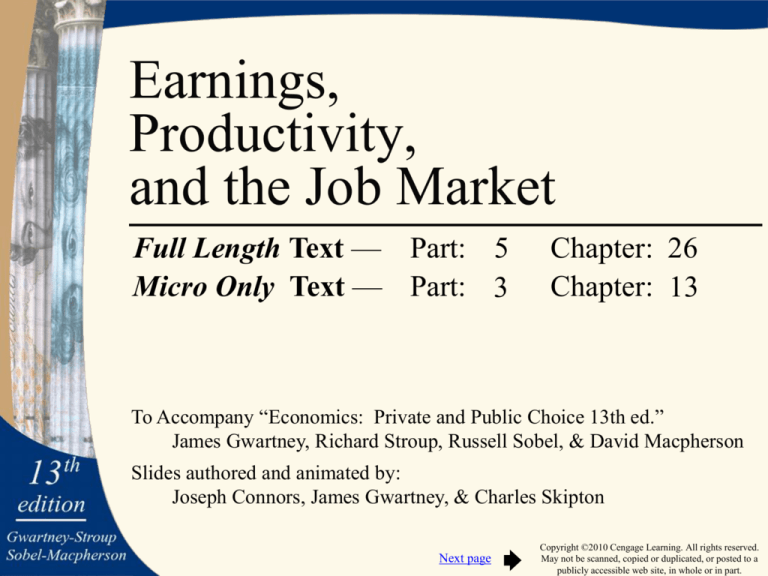
Earnings,
Productivity,
and the Job Market
Full Length Text — Part: 5
Micro Only Text — Part: 3
Chapter: 26
Chapter: 13
To Accompany “Economics: Private and Public Choice 13th ed.”
James Gwartney, Richard Stroup, Russell Sobel, & David Macpherson
Slides authored and animated by:
Joseph Connors, James Gwartney, & Charles Skipton
Next page
Copyright ©2010 Cengage Learning. All rights reserved.
May not be scanned, copied or duplicated, or posted to a
publicly accessible web site, in whole or in part.
Why Do Earnings Differ?
Jump to first page
Copyright ©2010 Cengage Learning. All rights reserved.
May not be scanned, copied or duplicated, or posted to a
publicly accessible web site, in whole or in part.
Why Do Earnings Differ?
• Earnings would be equal if:
• all individuals were identical
• all jobs were equally attractive
• workers were perfectly mobile among jobs
Jump to first page
Copyright ©2010 Cengage Learning. All rights reserved.
May not be scanned, copied or duplicated, or posted to a
publicly accessible web site, in whole or in part.
Earnings Differentials
Due to Non-identical Workers
• Worker productivity:
• More productive workers have greater
earnings.
• Worker preferences:
• Workers motivated by monetary objectives are
likely to pursue jobs with higher wages.
• Race and gender:
• Discrimination may lower earnings
opportunities of minorities and women.
Jump to first page
Copyright ©2010 Cengage Learning. All rights reserved.
May not be scanned, copied or duplicated, or posted to a
publicly accessible web site, in whole or in part.
Earnings Differences
of Skilled and Unskilled Workers
Wages
Ds
• The productivity and thus marginal
product of skilled workers is greater
than that of unskilled workers.
• Hence, the demand for skilled
workers Ds exceeds the demand for
unskilled workers Du.
Du
Wages
Quantity
• Education and training generally
enhance skill.
• Because it is costly to upgrade skills
through investments in human
capital, the supply of skilled workers
Ss is smaller than the supply of
unskilled workers Su.
Jump to first page
Ss
Su
Quantity
Copyright ©2010 Cengage Learning. All rights reserved.
May not be scanned, copied or duplicated, or posted to a
publicly accessible web site, in whole or in part.
Earnings Differences
of Skilled and Unskilled Workers
• The wages of skilled workers are high relative to unskilled
workers due to the strong demand and small supply of
skilled workers relative to unskilled workers.
Wages
Ss
Su
Ws
Ds
Wu
Du
Quantity
Jump to first page
Copyright ©2010 Cengage Learning. All rights reserved.
May not be scanned, copied or duplicated, or posted to a
publicly accessible web site, in whole or in part.
Level of Education and Earnings
• The mean earnings
of males & females
by education level
in 2007 are listed
to the right.
• The earnings of
both men & women
increase with
education.
• Note, though, that
women’s earnings
were only about 2/3
those of similarly
educated men.
Less than
high school
High
school
Some
college
Bachelor’s
degree
Men
30,602
Women
21,906
42,042
30,657
50,103
38,396
77,536
52,857
Master’s
degree
94,763
63,156
132,706
Doctoral
degree
85,190
Mean earnings ($) of
year-round-full-time workers (2007)
Jump to first page
Copyright ©2010 Cengage Learning. All rights reserved.
May not be scanned, copied or duplicated, or posted to a
publicly accessible web site, in whole or in part.
Earnings Differentials
Due to Non-Identical Jobs
• Jobs with undesirable working conditions
will command higher wages (compensating
wage differentials).
• Compensating wage differentials arise from
a variety of factors such as:
•
•
•
•
Job risk
Job location
Working hours
Work environment
Jump to first page
Copyright ©2010 Cengage Learning. All rights reserved.
May not be scanned, copied or duplicated, or posted to a
publicly accessible web site, in whole or in part.
Earnings Differentials
Due to Immobility of Labor
• Some wage differentials result from an
incomplete adjustment to a change in labor
demand because of labor immobility.
• Immobility can result from:
• Specialized labor
• Institutional barriers
• minimum wage
• occupational licensing
• labor unions
Jump to first page
Copyright ©2010 Cengage Learning. All rights reserved.
May not be scanned, copied or duplicated, or posted to a
publicly accessible web site, in whole or in part.
The Economics of
Employment Discrimination
Jump to first page
Copyright ©2010 Cengage Learning. All rights reserved.
May not be scanned, copied or duplicated, or posted to a
publicly accessible web site, in whole or in part.
Wage Discrimination
• When white workers are preferred to
minority workers (or men to women), the
demand for minority workers is reduced.
• Minority workers receive lower wages.
Jump to first page
Copyright ©2010 Cengage Learning. All rights reserved.
May not be scanned, copied or duplicated, or posted to a
publicly accessible web site, in whole or in part.
Impact of Wage Discrimination
Wages
• If there is employment
discrimination against
minorities (or women),
the demand for their
services will decline.
• As a result of this lower
demand, the equilibrium
wage for minorities will
be lower, Ww > Wm .
S
A
Ww
B
Wm
Dwhites
Dminorities
Qm Qw
Jump to first page
Employment
Copyright ©2010 Cengage Learning. All rights reserved.
May not be scanned, copied or duplicated, or posted to a
publicly accessible web site, in whole or in part.
Employment Discrimination
• When discrimination is present, the entry
of minority workers into some types of jobs
and occupations may be restricted.
• If so, the supply in unrestricted jobs will
increase, causing wages to fall in these jobs.
• When the supply of minorities (or women)
to an occupation is restricted, the wages of
white males will rise.
Jump to first page
Copyright ©2010 Cengage Learning. All rights reserved.
May not be scanned, copied or duplicated, or posted to a
publicly accessible web site, in whole or in part.
Employment Discrimination
• Discrimination is costly to employers.
• When employers can hire equally productive
minorities (or women) at a lower wage than
whites (men), the profit motive gives them a
strong incentive to do so.
• Employers who ignore minority and
gender status when employing workers
will have lower wage costs than employers
who discriminate.
Jump to first page
Copyright ©2010 Cengage Learning. All rights reserved.
May not be scanned, copied or duplicated, or posted to a
publicly accessible web site, in whole or in part.
Employment Discrimination
and Earnings of Minorities
• Earnings may differ among groups for
reasons besides employment discrimination.
• To measure the extent of employment
discrimination, we must
• adjust earnings for differences between
groups in productivity-related factors such
as education, and,
• then make comparisons between similarly
qualified groups of workers who differ only
in race or gender.
Jump to first page
Copyright ©2010 Cengage Learning. All rights reserved.
May not be scanned, copied or duplicated, or posted to a
publicly accessible web site, in whole or in part.
The Actual and Productivity-Adjusted Wages
of Minorities Compared to Whites
2005-2008*
Men
White
African-American
American Indian
Asian-American a
Mexican-American
Other Hispanic
Women
Actual
Adjusted
Actual
Adjusted
100
77
79
104
65
75
100
84
92
91
88
88
100
89
94
107
73
83
100
92
98
94
93
92
a Primarily Chinese-Americans and Japanese-Americans.
* Data were supplied by David MacPherson, as derived from the 2005-2008
Current Population Surveys (CPS). Data were adjusted for years of
schooling, work experience, region, industry, sector of employment, union
status, and marital status.
Jump to first page
Copyright ©2010 Cengage Learning. All rights reserved.
May not be scanned, copied or duplicated, or posted to a
publicly accessible web site, in whole or in part.
Questions for Thought:
1. What are major factors that would help explain
earnings differences between the following:
a. a lawyer and a minister,
b. an accountant and a school teacher,
c. a business executive and a social worker,
d. a country lawyer and a Wall Street lawyer,
e. an experienced, skilled craftsperson and a
20-year-old high school dropout, and,
f. an upper-story & ground-floor window washer?
2. “If it were not for employment discrimination
against minorities, the average earnings of
minorities and whites would be equal.”
-- Is this true?
Jump to first page
Copyright ©2010 Cengage Learning. All rights reserved.
May not be scanned, copied or duplicated, or posted to a
publicly accessible web site, in whole or in part.
Questions for Thought:
3. “When employment discrimination results
from the personal prejudices of employers,
economic theory suggests that discrimination
by an employer will reduce production costs
since the employer can pay lower wages.”
-- Is this statement true, false, or uncertain?
4. If Congress suddenly passes legislation that
required all U.S. workers to receive the same
annual pay, then we would expect
a. less human capital investment
b. a shortage of workers to fill undesirable jobs
c. a surplus of workers to fill easy, desirable jobs
Jump to first page
Copyright ©2010 Cengage Learning. All rights reserved.
May not be scanned, copied or duplicated, or posted to a
publicly accessible web site, in whole or in part.
The Link Between
Productivity and Earnings
Jump to first page
Copyright ©2010 Cengage Learning. All rights reserved.
May not be scanned, copied or duplicated, or posted to a
publicly accessible web site, in whole or in part.
Productivity and Earnings
• Productivity is the source of high wages.
• Workers in the U.S. earn high wages
because their output per hour is high as
a result of:
• Greater worker knowledge and skills
(human capital)
• The use of modern machinery
(physical capital)
Jump to first page
Copyright ©2010 Cengage Learning. All rights reserved.
May not be scanned, copied or duplicated, or posted to a
publicly accessible web site, in whole or in part.
Productivity and Earnings
Annual rate of increase of productivity and real wages
3.2 %
2.6 %
2.8 %
1.7 %
1.5 %
0.7 %
1948–1973
Rise in output per hour
1974–1995
1996–2008
Rise in real compensation
(private business sector)
(private business sector)
• Productivity & compensation per hour are closely related.
• Relative to the 1948-1973 period, growth in productivity
and real wages slowed during 1973 - 1995. Both
rebounded substantially during the 1996-2008 time frame.
Jump to first page
Copyright ©2010 Cengage Learning. All rights reserved.
May not be scanned, copied or duplicated, or posted to a
publicly accessible web site, in whole or in part.
Productivity Rebound
• Productivity rebounded significantly between
1996 and 2008 after being relatively low for
the previous 20 years.
• Most economists believe that the increase in
productivity growth is the result of the recent
computer revolution and related technological
innovations.
• If the acceleration in productivity continues,
increases in wages in the years ahead will be
more rapid than during the 1974-1995 period.
Jump to first page
Copyright ©2010 Cengage Learning. All rights reserved.
May not be scanned, copied or duplicated, or posted to a
publicly accessible web site, in whole or in part.
Automation
• Automated methods of production will only
be adopted if they reduce costs.
• Automation may reduce employment in a
specific industry.
• But, it also releases resources that can be
employed in other areas.
• Improved technology permits us to achieve
larger output and income levels.
Jump to first page
Copyright ©2010 Cengage Learning. All rights reserved.
May not be scanned, copied or duplicated, or posted to a
publicly accessible web site, in whole or in part.
Questions for Thought:
1. Why are wages higher in the United States
than in India or China?
2. “Jobs are the key to economic progress.
Unless we create more jobs, our standard
of living will fall.”
-- Is this statement true or false?
3. Do you think the market system of wage
determination is fair? Why or why not? Can
you think of a more equitable system? If so,
explain why it is more equitable.
Jump to first page
Copyright ©2010 Cengage Learning. All rights reserved.
May not be scanned, copied or duplicated, or posted to a
publicly accessible web site, in whole or in part.
End
Chapter 26
Jump to first page
Copyright ©2010 Cengage Learning. All rights reserved.
May not be scanned, copied or duplicated, or posted to a
publicly accessible web site, in whole or in part.




